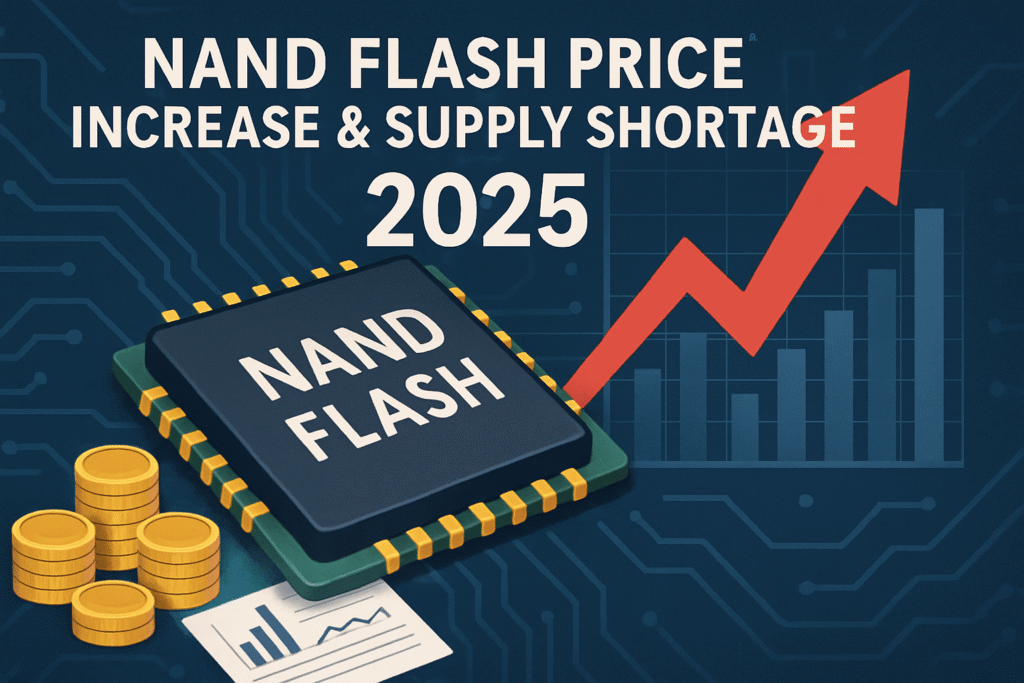The semiconductor industry is bracing for another seismic shift as NAND flash memory prices are set to climb in Q3 2025, with supply shortages expected to persist into 2026. Driven by production cuts, soaring AI-driven demand, and a pivot to high-margin products, this price surge could ripple across consumer electronics, from smartphones to SSDs.
Why NAND Prices Are Climbing?
NAND flash, the memory tech powering SSDs, smartphones, and data centers, is entering a period of scarcity. Industry sources, including TrendForce, report that NAND prices are projected to rise by 5-10% in Q3 2025, with chips under 512Gb facing the steepest hikes. This follows a strategic shift by major players like Micron, SanDisk, and Samsung, who began slashing production in late 2024 to curb oversupply and boost margins. These cuts have tightened the market, with wafer prices for 3D NAND (TLC and QLC) expected to jump 8-13% this quarter.
The AI boom is a key driver. Data centers fueling generative AI and cloud services demand high-capacity NAND for enterprise SSDs, squeezing supply for consumer products. Meanwhile, smartphone and PC markets, though recovering, are seeing conservative orders due to economic uncertainty, further straining availability.

From Glut to Shortage of NAND
Just a year ago, the NAND market was drowning in oversupply. In 2023, flash revenues plummeted 39.9% to $36.674 billion, hit hard by weak PC and smartphone demand. Memory giants like Samsung and SK Hynix faced hefty losses, prompting aggressive production cuts. By Q4 2023, Samsung reduced its NAND output by nearly 50%, a move echoed by others like Kioxia and Western Digital. These reductions, combined with a shift toward high-margin products like QLC NAND for AI applications, flipped the market from surplus to scarcity.
Now, the pendulum has swung. TrendForce notes that suppliers are prioritizing enterprise SSDs and high-capacity chips, leaving low-capacity TLC wafers in short supply. This dynamic is compounded by external pressures: a strengthening Taiwan dollar, U.S. export controls limiting China’s access to advanced chips, and tariff threats that could inflate costs. The result? A market where demand is outpacing supply, and prices are climbing fast.
The Consumer and Industry Impact
Unlike past NAND price surges driven by temporary demand spikes, this one feels structural. The industry’s pivot to AI and data centers is reshaping priorities. Suppliers are betting big on high-margin enterprise products, sidelining consumer-grade NAND. This could mean higher prices for everyday gadgets—think pricier SSDs, laptops, and smartphones—especially as holiday shopping ramps up. For consumers, this might translate to sticker shock for devices in 2026, particularly budget models reliant on low-capacity NAND.
For the industry, the shortage highlights a broader challenge: balancing innovation with accessibility. While AI-driven demand is a boon for companies like Micron and SK Hynix, the focus on premium products risks alienating smaller manufacturers and emerging markets. India, for instance, is pushing to become a semiconductor hub, but supply constraints could hamper its growth if NAND prices soar. Meanwhile, the shift to advanced nodes like Samsung’s 236-layer NAND or Kioxia’s 90% capacity utilization signals a race for efficiency, but it’s not enough to close the supply gap yet.
Challenges Ahead: Geopolitical and Economic Risks
The NAND market’s recovery isn’t without hurdles. U.S. tariffs could raise chip costs, impacting affordability. Geopolitical tensions, including export controls on China, limit market access for some suppliers, further tightening supply. Additionally, the industry faces a talent crunch—needing 1 million skilled workers by 2030—and equipment shortages, particularly for advanced packaging like TSMC’s CoWoS, which indirectly affects NAND production.
Currency fluctuations are another headache. TSMC’s Q2 margins dipped due to a strong Taiwan dollar, and similar pressures could hit NAND makers. If macroeconomic conditions worsen, consumer demand for PCs and smartphones might soften, complicating suppliers’ pricing strategies. Yet, the AI sector’s relentless growth offers a buffer, with enterprise SSDs and high-bandwidth memory (HBM) soaking up capacity.
Check out TSMC’s Q2 Profit Soars 60% to Record Highs, Fueled by AI Boom: What’s Next for the Chip Giant?
What’s Next for NAND and the Semiconductor Industry?
Looking ahead, the NAND market is at a tipping point. TrendForce warns that inventory buildup and weak seasonal demand could push prices down 10-15% in Q1 2026, but only if suppliers ramp up production too quickly. For now, the shortage narrative dominates, with prices likely to stay elevated through 2025. Companies like Western Digital are already notifying customers of price hikes, and Samsung is eyeing 20% increases for early 2026.
For consumers, proactive planning is key. Businesses and individuals might consider securing SSDs or memory-heavy devices before prices peak. For investors, NAND suppliers like Micron and SK Hynix are poised for gains, but volatility looms due to geopolitical risks and currency shifts. The broader semiconductor industry, meanwhile, must navigate this crunch while investing in next-gen tech—think photonic chips or quantum AI—to stay ahead.
The NAND flash surge is a microcosm of the semiconductor industry’s 2025 story: a tug-of-war between innovation and constraint. As AI reshapes demand and geopolitics tests resilience, the chips in our devices are becoming both more critical and harder to come by. Stay tuned for updates as this shortage unfolds.
Discover more from VLSIFacts
Subscribe to get the latest posts sent to your email.